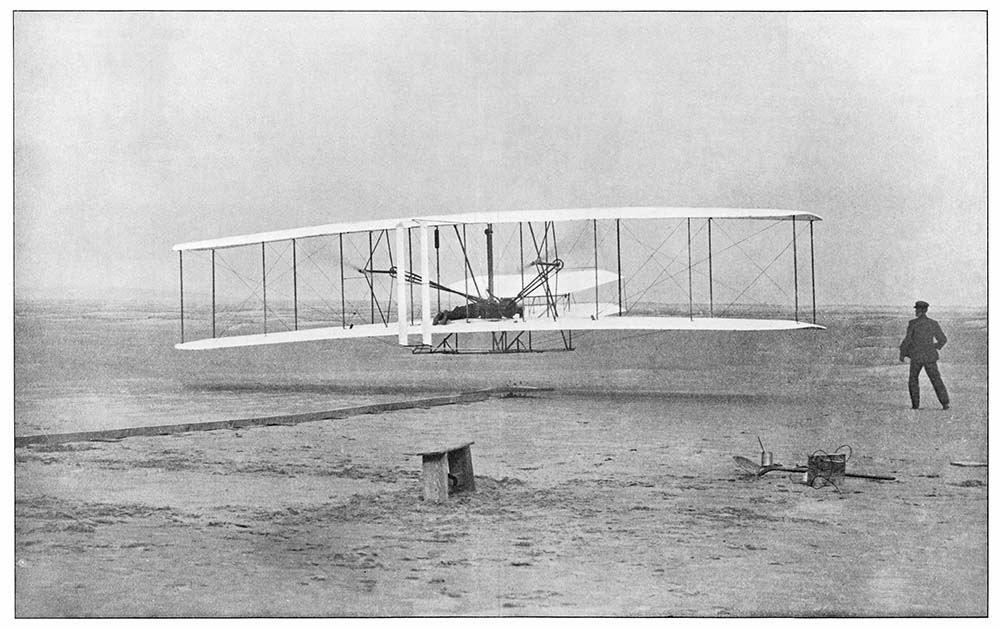The history of aerospace machining begins with the history of flight.
 Humans have always been intrigued by the idea of flying. We know this fact from early cave drawings and ancient Greek myths, such as the tale of Icarus, whose wings (made of feathers and attached with wax) melted when he flew too near the sun.
Humans have always been intrigued by the idea of flying. We know this fact from early cave drawings and ancient Greek myths, such as the tale of Icarus, whose wings (made of feathers and attached with wax) melted when he flew too near the sun.
During the Renaissance, Leonardo Da Vinci drew more than 200 detailed sketches of wings and flying machines, some of which are startlingly ahead of his time.
In 1857, a French naval officer named Félix du Temple de la Croix earned the patent for a flying machine. And in 1874, his lightweight steam-powered monoplane flew a short distance under its own power after taking off from a ski jump.
However, the honor of the first controlled, powered, and sustained flight goes to Americans Orville and Wilbur Wright. In 1903 near Kitty Hawk, North Carolina, Wilbur Wright flew their plane for 59 seconds over a distance of 852 feet. Two years later, the Wright Brothers surpassed their own achievement when they built and flew the first fully practical airplane. The Wright Flyer featured a lightweight aluminum engine, wood and steel construction, and a fabric wing warping.
From that time on, engineers have experimented with new materials and metals in their quest to conquer the skies and the vast space above them.
Here are some highlights of the history of the aerospace industry. With each step, machining processes adapted and led to changes that fueled innovations and designs.
The 1910s. In 1915, Hugo Junkers designed a corrugated sheet iron-covered tubular-framed metal airplane fuselage. Although the metal surface made the plane stronger and able to carry more weight than the previous aircraft, its rough surface caused considerable drag. With custom-crafted surfaces, the aircraft also was time-consuming to produce and assemble.
Airplanes were used for the first time in warfare as daring pilots fought each other in the air over Europe during World War I.
The 1920s. Airplanes became part of high-stakes racing competitions, so designers focused on performance. Howard Hughes and other innovators found that monoplanes were more aerodynamic than biplanes and that frames made of aluminum were more lightweight and fuel-efficient.
The 1930s. The use of wood in aircraft becomes obsolete as all-metal pales become the norm. Aluminum ushers in sleek aircraft exteriors and less expensive, lighter-weight machining.
The 1940s. The need for military aircraft spurs more innovations, such as stainless-steel construction and superalloys. Some metal parts are replaced with rubber parts, and high-grade plastics replace some mechanical components and aluminum parts.
The 1950s. After World War II, jet propulsion and other new technological advances lead to further changes in manufacturing processes and techniques.
The 1960s. The use of titanium and plastics further modernizes airplanes and spacecraft, making them lighter and more fuel-efficient. NASA scientists use Kevlar, layers of nylon, and other plastics to protect spacecraft crew from extreme temperatures.
The 1970s. Carbon fiber composites become part of aerospace machining. Although these materials are lightweight, they can have a tensile strength five times greater than steel. Plastic and epoxy resins combine as composite aerospace components to form a matrix that allows fibers to remain intact as one-piece designs.
The 1980s. The next step in aerospace machining involves using pre-formed components that reduce the number of heavy fasteners and joints needed in an aircraft. One-piece designs are used wherever possible, eliminating potential weak spots.
The 1990s to today. High-grade plastics (like PEEK) are used for lightweight radiation shielding for the International Space Station and researched for flights to Mars. New composite materials and metals are developed to increase strength, heat and corrosion resistance, and lighter weights.
Millions of Parts
Modern aircraft manufacturing has been called “a craft process with a mass-production mentality.”
The aerospace industry includes an astonishing array of flight vehicles, ranging from military aircraft to private helicopters and spacecraft to long-range missiles. Customers range from large corporations to private individuals and telecommunications companies to government agencies.
What these vehicles have in common is that they require precision parts. Large aircraft vehicles consist of one million to five million separate parts, and complex spacecraft contain several hundred thousand parts. Each different piece requires unique manufacturing methods and skills.
No single company builds an entire flight vehicle because of the range of skills and facilities needed to manufacture these parts. In fact, aerospace manufacturing cuts a wide swath across multiple industries. Machine shops create mechanical components, clean rooms create electronic parts, and huge facilities build and house jumbo jets, space vehicles, and missiles.
Fabrication involves the manufacture of the individual components that make up larger assemblies or the end products themselves. Metals are cut, shaped, and otherwise formed by tools and machines operated manually or under the programmed control of computers.
Skillcraft: Proud to Play a Role in the Aerospace Industry
Founded in 1946, Skillcraft Machine Tool Co., Inc. manufactures high-quality support equipment, prototype components, and complex assemblies for the aerospace industry. The company specializes in producing small to medium size lots of parts and components in a variety of materials for a wide range of customers. Contact us today to discuss your next project.
